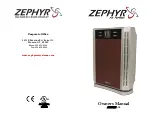
7 Installation
Installer reference guide
40
RRLQ004~008CA + RHBH/X04+08CB
ROTEX HPSU low temperature Bi‑bloc
4P384979-1 – 2015.01
NOTICE
Precautions when laying power wiring:
▪ Do not connect wiring of different thicknesses to the
power terminal block (slack in the power wiring may
cause abnormal heat).
▪ When connecting wiring which is the same thickness,
do as shown in the figure below.
▪ For wiring, use the designated power wire and connect
firmly, then secure to prevent outside pressure being
exerted on the terminal board.
▪ Use an appropriate screwdriver for tightening the
terminal screws. A screwdriver with a small head will
damage the head and make proper tightening
impossible.
▪ Over-tightening the terminal screws may break them.
Tightening torques
Item
Tightening torque (N•m)
M4 (X1M)
1.2~1.5
M4 (earth)
7.9.5
To connect the electrical wiring on the
outdoor unit
1
Remove the 2 switch box cover screws.
2
Remove the switch box cover.
2×
1
2
3
Strip insulation (20 mm) from the wires.
a
b
a
Strip wire end to this point
b
Excessive strip length may cause electrical shock or
leakage.
4
Open the wire clamp.
5
Connect the interconnection cable and power supply as follows:
3×
1 2 3
6
Install the switch box cover.
7.9.6
To connect the electrical wiring on the
indoor unit
1
To open the indoor unit, see
"7.2.3 To open the indoor unit" on
2
Wiring should enter the unit from the bottom.
3
Routing of the wiring inside the unit should be as follows:
a
b
c
a
b
c
INFORMATION
When installing field supply or option cables, foresee
sufficient cable length. This will make it possible to remove/
reposition the switch box and gain acces to other
components during service.
Routing
Possible cables (depending on unit type and installed options)
a
Low voltage
▪ Preferential power supply contact
▪ User interface
▪ Domestic hot water tank thermistor (option)
▪ Power consumption digital inputs (field supply)
▪ Outdoor ambient temperature sensor (option)
▪ Electrical meters (field supply)
















































